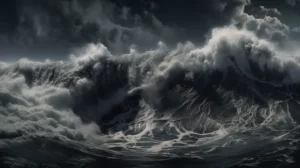Hurricanes, also known as tropical cyclones or typhoons in different parts of the world, are among nature’s most awe-inspiring yet devastating phenomena. These colossal storms can wreak havoc on coastal regions, causing widespread destruction and loss of life. But have you ever wondered how hurricanes are formed? In this short article, we will delve into the intricate processes that give birth to these immense weather events, from their humble beginnings to their full-blown fury.
The Birth of a Hurricane: Ingredients and Conditions
Warm Ocean Waters: The Crucial Catalyst
At the heart of every hurricane lies warm ocean water. The process begins when the sea’s surface heats up, usually in tropical regions, during the warm summer months. Warm waters, with temperatures of at least 26.5 degrees Celsius (80 degrees Fahrenheit) or higher, provide the energy required to power a developing hurricane. These warm waters contribute to the evaporation of water, leading to the formation of moist, warm air.
Evaporation and Condensation: Building the Storm’s Foundation
As the sun’s heat causes water to evaporate from the ocean’s surface, it forms a warm, moist air mass. This air rises into the atmosphere, where it cools and condenses to form clouds. The release of latent heat during condensation further warms the air, causing it to rise rapidly and create an area of low pressure at the surface. This low-pressure zone becomes the core of the developing storm.
The Stages of Hurricane Formation
Tropical Disturbance: A Modest Beginning
The first stage in hurricane formation is a tropical disturbance. This refers to a cluster of thunderstorms in the ocean that exhibits some degree of organization. While not yet a full-fledged hurricane, this disturbance sets the stage for further development. Winds within a tropical disturbance are usually below 20 knots.
Tropical Depression: Gaining Strength
When a tropical disturbance becomes more organized and its wind speeds increase, it can evolve into a tropical depression. At this stage, the system’s winds rotate around a center, and sustained wind speeds range between 20 and 34 knots. As the depression continues to gather energy from warm ocean waters, it sets the course for intensification.
Tropical Storm: The Emerging Tempest
As a tropical depression gains even more strength, with sustained winds ranging from 35 to 64 knots, it advances to become a tropical storm. This is the point at which the storm is given a name. The cyclonic circulation becomes more defined, and the storm’s structure becomes more organized.
From Tropical Storm to Hurricane: The Climactic Transformation
Rapid Intensification: The Storm’s Fury Unleashed
When a tropical storm’s conditions are just right—such as warm ocean waters and low vertical wind shear—the storm can undergo rapid intensification. This is a critical phase in which the storm’s wind speeds escalate dramatically, and it evolves into a full-fledged hurricane. The eye of the hurricane, a region of calm surrounded by the storm’s most ferocious winds, becomes more pronounced.
Categories of Hurricanes: Measuring the Power
Hurricanes are categorized based on the Saffir-Simpson Hurricane Wind Scale, which ranges from Category 1 (weakest) to Category 5 (strongest). The categorization is determined by the hurricane’s sustained wind speeds, which can reach over 157 mph (252 km/h) for a Category 5 hurricane. The higher the category, the more catastrophic the potential damage.
Respect for Nature’s Might
In conclusion, understanding how hurricanes are formed provides us with profound insights into the astonishing power of nature. From the humble beginnings of a tropical disturbance to the awe-inspiring force of a Category 5 hurricane, these immense storms serve as a reminder of our planet’s intricate and interconnected systems. While we have made great strides in predicting and preparing for these natural events, the key to minimizing their impact lies in our ongoing commitment to environmental stewardship and disaster preparedness.










